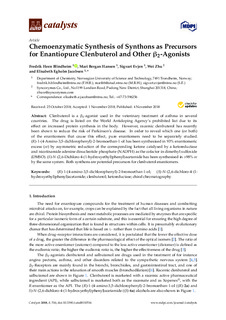| dc.contributor.author | Blindheim, Fredrik Heen | |
| dc.contributor.author | Hansen, Mari Bergan | |
| dc.contributor.author | Evjen, Sigvart | |
| dc.contributor.author | Zhu, Wei | |
| dc.contributor.author | Jacobsen, Elisabeth Egholm | |
| dc.date.accessioned | 2019-04-05T10:39:56Z | |
| dc.date.available | 2019-04-05T10:39:56Z | |
| dc.date.created | 2018-11-22T10:12:29Z | |
| dc.date.issued | 2018 | |
| dc.identifier.citation | Catalysts. 2018, 8 (11), 1-12. | nb_NO |
| dc.identifier.issn | 2073-4344 | |
| dc.identifier.uri | http://hdl.handle.net/11250/2593475 | |
| dc.description.abstract | Clenbuterol is a β2-agonist used in the veterinary treatment of asthma in several countries. The drug is listed on the World Antidoping Agency’s prohibited list due to its effect on increased protein synthesis in the body. However, racemic clenbuterol has recently been shown to reduce the risk of Parkinson’s disease. In order to reveal which one (or both) of the enantiomers that cause this effect, pure enantiomers need to be separately studied. (R)-1-(4-Amino-3,5-dichlorophenyl)-2-bromoethan-1-ol has been synthesised in 93% enantiomeric excess (ee) by asymmetric reduction of the corresponding ketone catalysed by a ketoreductase and nicotinamide adenine dinucleotide phosphate (NADPH) as the cofactor in dimethyl sulfoxide (DMSO). (S)-N-(2,6-Dichloro-4-(1-hydroxyethyl)phenyl)acetamide has been synthesised in >98% ee by the same system. Both synthons are potential precursors for clenbuterol enantiomers. | nb_NO |
| dc.language.iso | eng | nb_NO |
| dc.publisher | MDPI | nb_NO |
| dc.rights | Navngivelse 4.0 Internasjonal | * |
| dc.rights.uri | http://creativecommons.org/licenses/by/4.0/deed.no | * |
| dc.subject | Asymmetrisk syntese | nb_NO |
| dc.subject | Asymmetric synthesis | nb_NO |
| dc.subject | Kromatografiske metoder | nb_NO |
| dc.subject | Chromatographic methods | nb_NO |
| dc.subject | Biokatalyse | nb_NO |
| dc.subject | Biocatalysis | nb_NO |
| dc.title | Chemoenzymatic Synthesis of Synthons as Percursors for Enantiopure Clenbuterol and Other β2-Agonists | nb_NO |
| dc.type | Journal article | nb_NO |
| dc.type | Peer reviewed | nb_NO |
| dc.description.version | publishedVersion | nb_NO |
| dc.subject.nsi | VDP::Organisk kjemi: 441 | nb_NO |
| dc.subject.nsi | VDP::Organic chemistry: 441 | nb_NO |
| dc.source.pagenumber | 1-12 | nb_NO |
| dc.source.volume | 8 | nb_NO |
| dc.source.journal | Catalysts | nb_NO |
| dc.source.issue | 11 | nb_NO |
| dc.identifier.doi | 10.3390/catal8110516 | |
| dc.identifier.cristin | 1633613 | |
| dc.description.localcode | © 2018 by the authors. Licensee MDPI, Basel, Switzerland. This article is an open access article distributed under the terms and conditions of the Creative Commons Attribution (CC BY) license (http://creativecommons.org/licenses/by/4.0/). | nb_NO |
| cristin.unitcode | 194,66,25,0 | |
| cristin.unitname | Institutt for kjemi | |
| cristin.ispublished | true | |
| cristin.fulltext | postprint | |
| cristin.qualitycode | 1 | |

